Samurai swords are made in Japan.. A long tradition of craftsmanship and ultimate precision

The remote city of Seki, far from the capital, has a long history of making samurai swords during the Warring States period in Japan. Because the residents there are proud of their heritage, they have preserved and developed it and moved it to the stage of peaceful industries, so that their city becomes one of the most famous cities in the world in the manufacture of cutlery and others, and it acquires the lion's share of the global market in this field.
City of War Swords
Seki City in Gifu Prefecture is famous for making high quality cutlery. Located about 40 kilometers north of Nagoya in central Japan, this city has a population of only 80,000 and is one of three major regions that are world centers for tableware production along with Solingen, Germany and Sheffield, England. It is home to about 300 cutlery businesses and its production alone accounts for about half of Japan's cutlery exports.
The history of Seki as a center for making fine blades began about 800 years ago during the Kamakura period (1185-1333), when a swordsmith from Yamato Prefecture (present-day Nara) moved to Seki, then part of Mino Prefecture, and established his own workshop. A few years later, during the Nanbokucho period (1336-1392), this blacksmith became influential in the establishment of the Mino-den school, which is among the five famous schools of Japanese swordmaking. Mino-den swords were known to be “unbreakable, unbreakable, and unbending,” making them the most treasured possessions of samurai warriors.
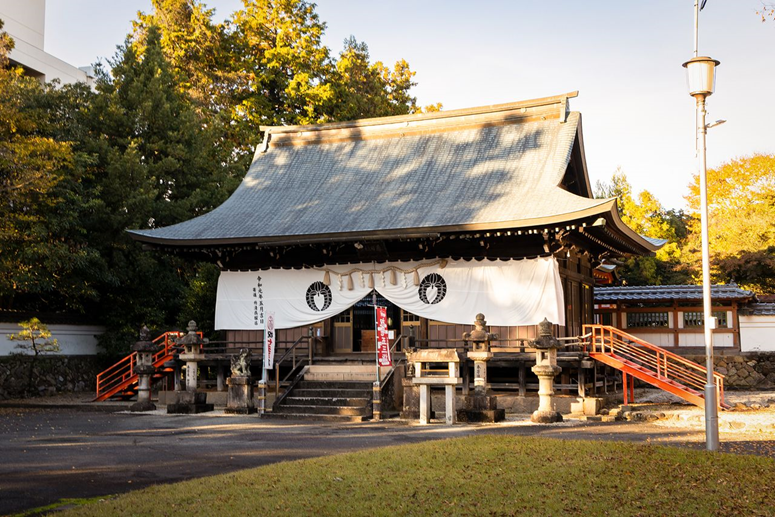
Kasuga Shrine in the city of Seki. Founded as a branch of the main shrine in Yamato Prefecture in 1288, it is dedicated to the guardian deity of the blacksmiths.
Izuminokami Kanesada is considered the undisputed best swordsmith in Mino history. Beginning with the Kasen Kanesada sword, owned by the powerful first lord of the Kokura region Hosokawa Tadaoki, his swords were revered by well-known warlords of the Warring States period (1467-1568).
Another skilled craftsman of this period is Magoroku Kanemoto. Saitō Dosan, a daimyō of the period, is said to have given a sword bearing Magoroku's signature as a gift when marrying his daughter to the famous warrior Oda Nobunaga; As well as the writer Mishima Yukio, who committed suicide in 1970 using one of the war swords made by Magoroku.
Delve deeper into the rich history of the city of Seki by visiting the Museum of Traditional Swords of the City of Seki, which displays historical materials and supplies of swords and knives that show the ingenuity of the blacksmiths in the city of Seki, as well as live demonstrations of the techniques used in the process of melting and forging the traditional Japanese sword and the creations of the craftsmen specialized in engraving the elements exterior decorative.

Exhibits at the Museum of Traditional Swords in Ski City.

Sword made by Izuminokami Kanesada.
Nature appoints the city to its inevitable destiny
God has blessed Ski City with all the raw materials needed for blacksmithing, water, wood, and earth. The Tsubu and Nagara rivers flow through it, providing abundant, high-quality water for cooling the hot steel. The dense pine forests in the area also provide fuel for the furnaces. The red clay available in the city is also ideal for making yakibatsuchi, a mixture of water, clay, ash, and other ingredients needed in the steel processing process.
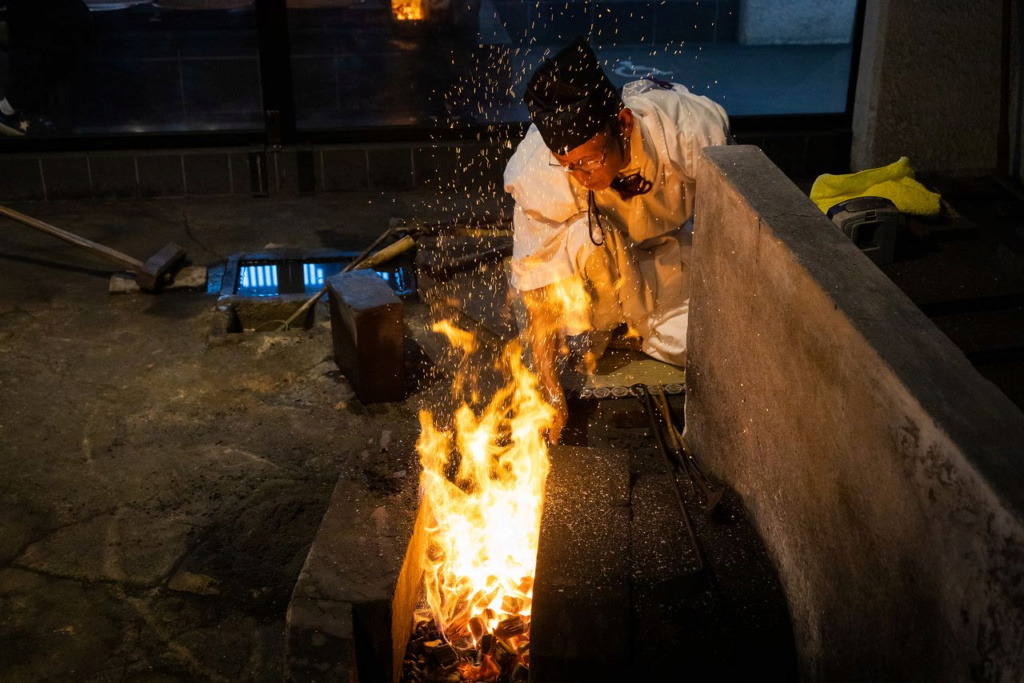
A swordsmith demonstrates his technique at the Museum of Traditional Swords in Ski City. Mino-den swords are forged from molten steel using pine charcoal.
The process of folding steel is one of the most important steps in making a Japanese sword, and it has a great impact on the quality of the blade, as the metal is first heated to 1300 degrees Celsius, then hammered and folded in half. It is then reheated, hammered and folded again, with the process repeated several times. This technology removes impurities and hardens the steel with each additional layer of metal.
Although this hardens the blade, it also makes the steel more brittle. To solve this problem, Magokoro devised a manufacturing method called shihō-zume in which different types of steel of varying hardness were used to assemble the sword, giving the blade strength and flexibility characteristic of Mino-den swords.

The yokusa (right) plays the main role in the process of shaping the sword. Using a small hammer, he sets the speed for the other workers, who hammer with larger hammers.
Once the sword has been shaped, a yakibatsuchi (a mixture of water, clay, and ash) is applied over the entire surface before cooling with only a thin layer applied to the side of the blade. The sword is then reheated for the first time in a forge before being immersed in water. The thin layer of yakibatsuchi allows the blade to cool quickly, giving it hardness, while the back part cools more slowly, increasing its flexibility and enhancing the sharpness and hardness of the sword.
As for the inscription on the blade, which appears on the part where the clay is thinly applied, it is the part in which the sword maker expresses his personality. The red clay of Seki has very few impurities, and the sanbonsugi inscription, Magoroku's signature, is clearly visible on the blade.

A sword made by Magoroku Kanemoto. It features a sanbonsogi pattern that resembles the silhouette of a row of cedar trees.
International cutlery
Besides making swords, Skii is famous for its blacksmiths called Nokage. Throughout the ages, the “smithing schools” produced such essential supplies as kitchen knives, razors, farming tools used in daily life, as well as custom-made cutlery to satisfy all tastes.
However, with the return of peace to Japan at the beginning of the Edo period (1603-1868), the demand for Japanese swords decreased, and many swordsmiths turned to making cutlery and other items (nokage) to earn a living. The art of sword-making came under further pressure during the Meiji era (1868-1912) when the government banned swords, forcing many swordsmiths to resort to exporting military swords and ornamental goods to earn a living.
Despite these developments, the techniques of making blades did not disappear, but were transmitted generation after generation, and these techniques are still followed today in the manufacture of cutlery used by people all over the world. Kai, which specializes in making tableware with the spirit of Nokage, is a perfect example of this.

Kai's headquarters.
Kai got its start in 1908 as a manufacturer of pocket knives, and in 1932 the company found success when it began selling Japan's first razor with a replaceable blade. In 1951, the razor with a long and thin blade was a huge success, which earned the company widespread recognition throughout the country.
The company currently boasts the largest market share in domestic disposable razors, nail clippers and household knives. It also manufactures medical products as well as barber scissors, chef's knives, and other professional cutlery. It is truly an international company that exports its products to 100 countries around the world, and its exports to the global market account for nearly half of its revenues.

Kai's long-blade razor blades, introduced to the market in 1951.
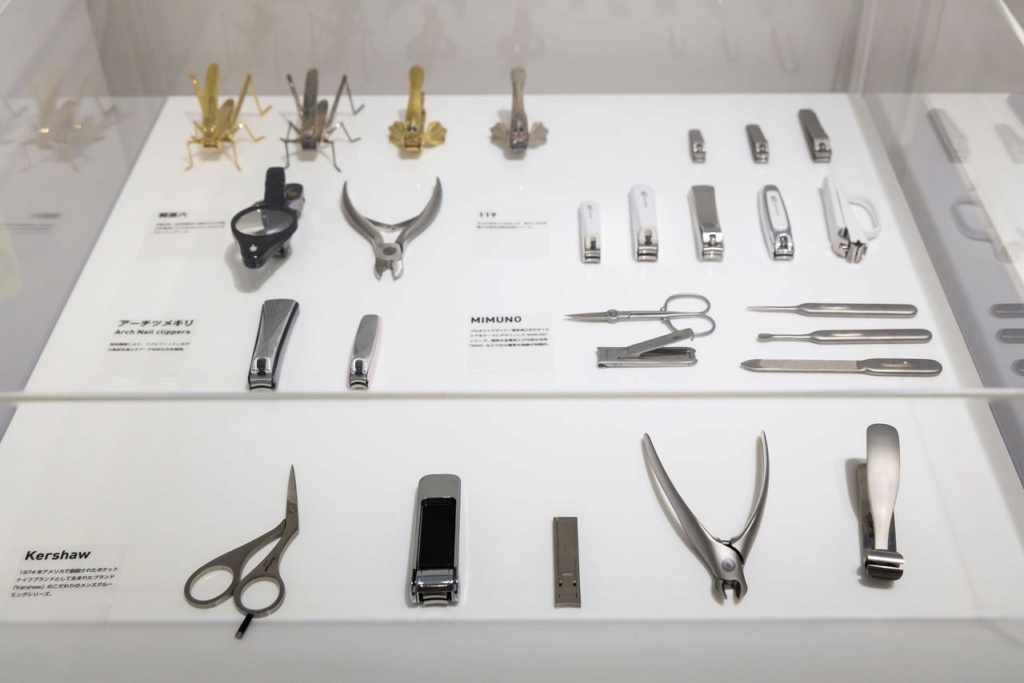
Kai has a wide variety of products, including all of the nail clippers shown here.
Over the past 40 years, Kai has followed in the footsteps of the great swordsmith Magoroku Kanemoto to develop its Seki Magoroku brand of cutlery, comprising more than 1,200 pieces that combine performance with beauty.
In particular, the assortment of household knives in this group is known for its sharpness reminiscent of Japanese swords, durability and affordability. They are products that truly embody the Nokage spirit.

Exhibits belonging to Kai's two main kitchen knife brands, Seki Magoroku and Shun.
Kitchen knives or small swords
The Kai Company's Yamato Tsurugi Factory is located in Gojo City, upstream of the Nagara River. It's where the company makes its Seki Magoroku Kaname kitchen knives, which it released in November 2022.
The blade of the knife is gently curved, reminiscent of the torii style, a Japanese swordmaking technique popular during the Kamakura period said to allow for efficient application of force. The angled shape is rooted in traditional Japanese knives, making it easier to slice meat. In addition, Kai pays attention to the smallest details, such as making the handle in an octagonal shape, which makes the knife easier to hold.
Otsuka Jun of Kai Design describes the knife as “beautiful, yet functional in design that makes it easy to use.” The knife bears a sanbunsugi engraving on its cutting edges, a tribute to the legacy of Magoroku Kanemoto.
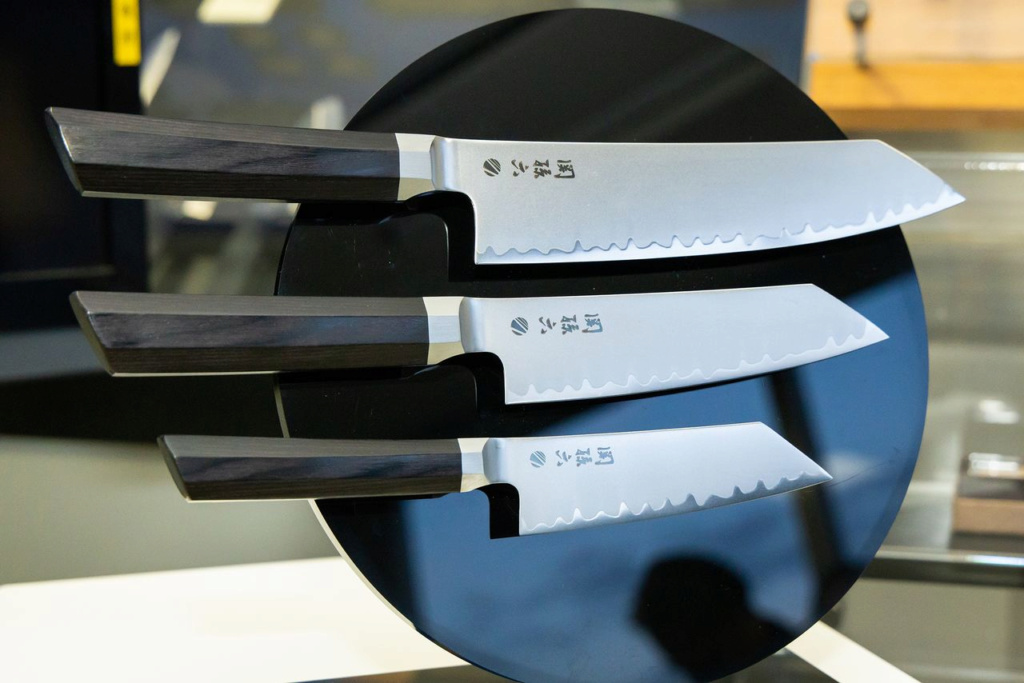
Seki Magoroku Kaname represents the pinnacle of the brand.
The manufacturing process is divided into approximately 30 steps in the factory, including surface grinding, polishing, and blade edging. The thickness of the cutting edge is measured in units of 0.1 millimeter, which is a manual process.
The sharpness of the knife ensures a precise cut, preserving the flavor and integrity of the ingredients. This feature is particularly important in traditional Japanese cuisine (washoku), which has grown in popularity worldwide. Kai is thus helping to support culinary traditions with its Kaname knives and other knives that are an extension of Skai's swordmaking heritage.
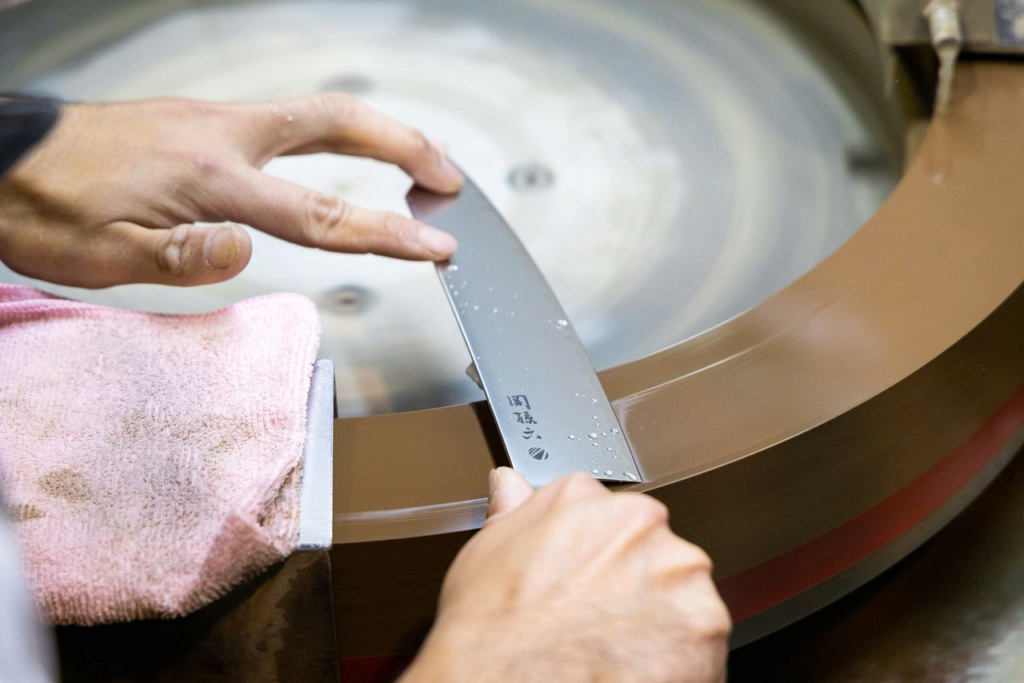
Sharpening wet type blades is one of the most important steps in the manufacturing process and is only performed by a craftsman with a long history of experience in this field.

The blade ensures a precise, beautiful cut every time.
Seki Museum of Traditional Sword Making
Address: 9-1 Minamikasuga, Seki, Gifu Prefecture
Opening hours: 9:00 - 16:30
Closed: Tuesdays, days after national holidays (excluding weekends), and New Year's holidays
Admission: adults 300 yen, high school students 200 yen, middle and elementary school students 100 yen
Access: About a 5-minute walk from Skaterasu Mae Station on the Nagaragawa Railway
Source : websites

